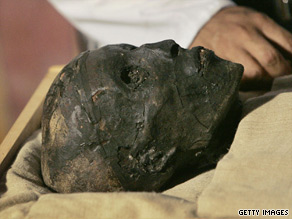
A long line of hospital staff wraps around the corridor outside a small conference room in New York to catch a glimpse of the precious cargo.
Inside are the three frail bodies in open wooden crates causing all the commotion. Another body -- a prince no less -- is a few rooms down in a computer tomography scanner.
The bodies are part of the Brooklyn Museum's collection of 11 Egyptian mummies, transported to the North Shore University Hospital to be scanned. The goal: Find out who they are, how they might have died and establish a chronology of advances in ancient Egypt's mummification techniques.
The process is not necessarily new. Egyptian mummies have been exposed to radiographic study since 1896 and CT scans, which conducts imaging by sections, for more than two decades.
Perhaps the most famous of them, King Tutankhamun (c. 1355-346 B.C.), was scanned in 2005 right outside the vault that holds his sarcophagus. The scan resulted in more than 17,000 images that were analyzed by an international team of radiologists, pathologists and anatomists, led by the world-renowned Zahi Hawass, the secretary general of Egypt's Supreme Council of Antiquities.
The scope and ability of CT scan technology are proving invaluable in learning more about the funeral rituals of ancient Egyptians and the mummies themselves. Whereas conventional X-rays cannot clearly distinguish soft tissue from bone and can see only two planes, CT scanning can differentiate among the various types of bone and soft tissue, and reconstruct three-dimensional images that "show fine detail inside coronary arteries down to 0.6 millimeters" said Amgad Makaryus, director of cardiac CT and magnetic resonance imaging at North Shore, providing a better chance at diagnosis and differentiation among diseases.
"CT has proved to be exceptionally well-suited for studying the fragile, wrapped figures of Egyptian mummies, especially those still contained within their decorated plasterlike shells, or cartonnages," according to an article by a team of eight researchers, led by Derek N.H. Notman, published in the American Journal of Roentgenology.
Read complete story at http://www.cnn.com/2009/TECH/science/06/25/mummy.scans/index.html

